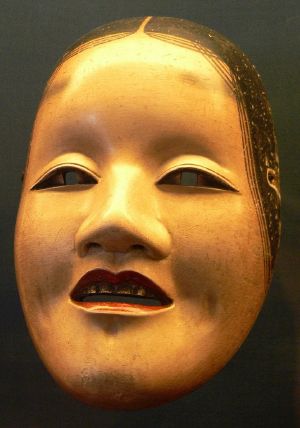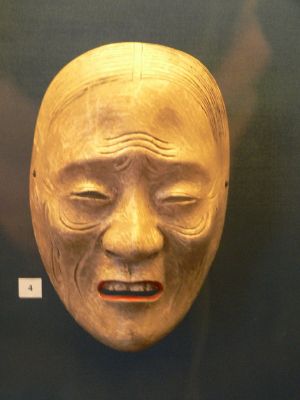Difference between revisions of "Noh" - New World Encyclopedia
Keisuke Noda (talk | contribs) (imported from wiki) |
m ({{Contracted}}) |
||
| Line 1: | Line 1: | ||
| + | {{Contracted}} | ||
:''NOU redirects here. For the airport with the same IATA code see [[La Tontouta International Airport]]'' | :''NOU redirects here. For the airport with the same IATA code see [[La Tontouta International Airport]]'' | ||
:''For Lady Noh, wife of [[Nobunaga Oda]], see [[Nohime]]. | :''For Lady Noh, wife of [[Nobunaga Oda]], see [[Nohime]]. | ||
Revision as of 21:20, 27 September 2006
- NOU redirects here. For the airport with the same IATA code see La Tontouta International Airport
- For Lady Noh, wife of Nobunaga Oda, see Nohime.
Noh or Nō (Japanese: 能) is a major form of classical Japanese musical drama that has been performed since the 14th century. Together with the closely-related kyogen farce, it evolved from various popular, folk and aristocratic art forms, including Dengaku, Shirabyoshi, and Gagaku. Surprisingly, although Noh has been slow and stylised for the past few centuries, its roots can be traced back to Chinese acrobatics, Sarugaku, and folk theatricals. Kan'ami and his son Zeami brought Noh to its present-day form during the Muromachi period. It would later influence other dramatic forms such as Kabuki and Butoh. During the Meiji era, although its governmental patronage was lost, Noh and kyogen received official recognition as two of the three national forms of drama.
Noh is unique in its slow, spartan grace and its use of distinctive masks.
Chant
Noh is a chanted drama, and some commentators have dubbed it "Japanese opera." However, the singing in Noh involves a limited tonal range, with lengthy, repetitive passages in a narrow dynamic range. Clearly, melody is not at the center of Noh singing. Still, texts are poetic, relying heavily on the Japanese seven-five rhythm familiar to all who know the earlier waka and the much-later haiku, with an economy of expression, and an abundance of allusion.
Stage, props, costumes
The Noh play takes place on a sparse stage made out of hinoki (Japanese cypress) wood. The stage is bare with the exception of the kagami-ita, a painting of a pine-tree at the back of the stage. There are many explanations for this tree, one of the more common being that it symbolizes a means by which deities were said to descend to earth in Shinto ritual. Another unique feature of the stage is the hashigakari, the narrow bridge to the left of the stage that the principal actors use to enter the stage. This would later evolve into the hanamichi in kabuki.
In contrast to the unadorned stage, costumes are lavish. Many actors, especially those in the shite role, wear rich silk brocades.
Roles
There are four major categories of Noh performers: Shite, Waki, Kyōgen, and Hayashi.
- The Shite are the most common form of actor in Noh.
- Shite (Primary actor)
- Tsure (Shite's companion)
- Jiutai (chorus, usually 6-8 actors)
- Koken (stage assistant, usually 2-3 actors).
- The Waki perform the role that is the counterpart or foil of the Shite.
- The Kyogen perform the aikyogen interludes during plays. Kyogen actors also perform in separate plays between individual noh.
- The Hayashi are the instrumentalists who play the four instruments used in Noh theater, the transverse flute (nohkan), hip-drum (okawa or otsuzumi), the shoulder-drum (kotsuzumi), and the stick-drum (taiko).
A typical Noh play will involve all categories of actors and usually takes 30-120 minutes.
Plays
There are approximately 250 plays in the current repertoire, and five categories, organized roughly by subject:
- 1st Category: God plays
- 2nd Category: Warrior plays
- 3rd Category: Woman plays
- 4th Category: Miscellaneous plays
- 5th Category: Demon plays
Okina (or Kamiuta) is a unique play that combines dance with Shinto ritual. It is considered the oldest type of Noh play, and is probably the most often performed. It will generally be the opening work at any programme or festival.
The Tale of the Heike, a medieval tale of the rise and fall of the Taira clan, originally sung by blind monks who accompanied themselves on the biwa, is an important source of material for Noh (and later dramatic forms), particularly warrior plays. Another major source is The Tale of Genji, an eleventh century work, which is acknowledged as the world's first novel. Authors also drew on Nara and Heian period Japanese classics, and Chinese sources.
The following categorization is that of the Kanze school.
- Aoi no Ue — Court Lady Aoi (Category 4)
- Dojoji — Dojoji (Category 4)
- Hagoromo — The Feather Mantle (Category 3)
- Izutsu — The Well Cradle (Category 3)
- Matsukaze — Pining Wind (Category 3)
- Sekidera Komachi — Komachi at Sekidera (Category 3)
- Shakkyo — Stone Bridge (Category 5)
- Shojo — The Tippling Elf (Category 3)
- Yorimasa — Yorimasa (Category 2)
- Yuya — Yuya (Category 3)
Some plays have been translated into English by Arthur Waley.
Actors
There are about 1500 professional Noh actors in Japan today, and the art form continues to thrive. The five extant schools of Noh acting are the Kanze (観世), Hōshō (宝生), Komparu (金春), Kita (喜多), and Kongō (金剛) schools. Each school has a leading family known as Sōke, and the head of each family is entitled to create new plays or edit existing songs. The society of Noh actors is quite feudalistic, and strictly protects the traditions passed down from their ancestors (see iemoto).
Aesthetic
According to Zeami, all Noh plays should create an aesthetic ideal called 'Yugen', meaning subtle and profound spirit, and 'Hana", meaning novelty. Noh truly represents the Japanese culture of finding beauty in subtlety and formality.
Masks in Noh plays
The masks in Noh (能面 nō-men or 面 omote, feature) all have names.
Usually only the Shite, the main actor, wears a mask. However, in some cases, the Tsure may also wear a mask, particularly for female roles. The Noh masks are used to portray female or nonhuman (divine, demonic, or animal) characters. There are also Noh masks to represent youngsters or old men. On the other hand, a Noh actor who wears no mask plays a role of an adult man in his twenties, thirties, or forties. The side player, waki, wears no mask either.
When used by a skilled actor, Noh masks have the ability to depict different emotional expressions according to head pose and lighting. An inanimate mask can have the appearance of being happy, sad, or a variety of subtle expressions. Studies by Michael J. Lyons a researcher based in Kyoto, and Ruth Campbell, at University College London, have explored this aspect of the masks [1].
See also
- Iemoto
External links
- Translations of thirteen Noh plays
- Kyogen: Classical Japanese Comic Theatre
- Studies of the variable expressions of Noh masks
- Virtual Reality and Virtual Irreality:On Noh-Plays and Icons
- Noh mask master Shigeharu Nagasawa Noh Masks / 長澤重春能面集 Japan
ar:نو br:Nō (c'hoariva) ca:Noh da:Noh de:Nō es:Nō eo:Noo fr:Théâtre nō ko:노 (연극) id:Noh it:Nō he:נו mt:No (teatru) nl:No-spel ja:能 no:No nn:No-drama pl:Nō pt:Noh ru:Но scn:Tiatru nô simple:Noh sh:Noh fi:Nō-teatteri sv:No-teater zh:能剧
{{Credit|75729506}]



